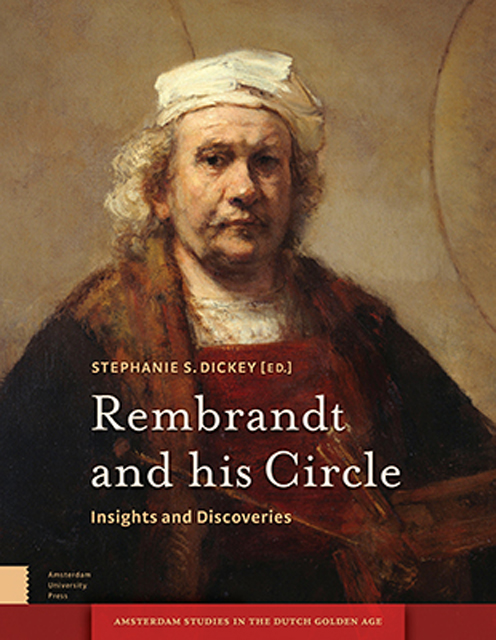Book contents
- Frontmatter
- Dedication
- Contents
- Acknowledgements
- Introduction
- 1 Rembrandt and Frans Hals Painting in the Workshop of Hendrick Uylenburgh
- 2 Rembrandt and the Germanic Style
- 3 Rembrandt and the Humanist Ideal of the Universal Painter
- 4 Curiosity and Desire: Rembrandt’s Collection as Historiographic Barometer
- 5 Painted Landscapes by Lievens and Rembrandt : The View from Seventeenth-Century Amsterdam Collections
- 6 Jan Lievens in Antwerp: Three Rediscovered Works
- 7 Gerrit Dou as a Pupil of Rembrandt
- 8 A New Painting by Jan van Noordt in Budapest
- 9 Rembrandt’s First Nude? The Recent Analysis of Susanna and the Elders from Rembrandt’s Workshop
- 10 Rembrandt’s Head of Christ: Some Technical Observations concerning Matters of Style
- 11 A Rediscovered Head of John the Baptist on a Platter from Rembrandt’s Studio
- 12 Rembrandt’s One Guilder Print: Value and Invention in ‘the most beautiful [print] that ever came from the burin of this Master’
- 13 Rembrandt, Ferdinand Bol, and Tobit: The Emergence of a Pathosträger
- 14 Biblical Iconography in the Graphic Work of Rembrandt’s Circle
- 15 Jan van Vliet and Rembrandt van Rijn: Their Collaboration Reassessed
- 16 Printmaking among Artists of the Rembrandt School
- 17 Chain Line Pattern Matching and Rembrandt’s Prints
- List of Illustrations
- Bibliography
- Index Nominum
10 - Rembrandt’s Head of Christ: Some Technical Observations concerning Matters of Style
Published online by Cambridge University Press: 21 January 2023
- Frontmatter
- Dedication
- Contents
- Acknowledgements
- Introduction
- 1 Rembrandt and Frans Hals Painting in the Workshop of Hendrick Uylenburgh
- 2 Rembrandt and the Germanic Style
- 3 Rembrandt and the Humanist Ideal of the Universal Painter
- 4 Curiosity and Desire: Rembrandt’s Collection as Historiographic Barometer
- 5 Painted Landscapes by Lievens and Rembrandt : The View from Seventeenth-Century Amsterdam Collections
- 6 Jan Lievens in Antwerp: Three Rediscovered Works
- 7 Gerrit Dou as a Pupil of Rembrandt
- 8 A New Painting by Jan van Noordt in Budapest
- 9 Rembrandt’s First Nude? The Recent Analysis of Susanna and the Elders from Rembrandt’s Workshop
- 10 Rembrandt’s Head of Christ: Some Technical Observations concerning Matters of Style
- 11 A Rediscovered Head of John the Baptist on a Platter from Rembrandt’s Studio
- 12 Rembrandt’s One Guilder Print: Value and Invention in ‘the most beautiful [print] that ever came from the burin of this Master’
- 13 Rembrandt, Ferdinand Bol, and Tobit: The Emergence of a Pathosträger
- 14 Biblical Iconography in the Graphic Work of Rembrandt’s Circle
- 15 Jan van Vliet and Rembrandt van Rijn: Their Collaboration Reassessed
- 16 Printmaking among Artists of the Rembrandt School
- 17 Chain Line Pattern Matching and Rembrandt’s Prints
- List of Illustrations
- Bibliography
- Index Nominum
Summary
Abstract
Building on technical studies conducted for the exhibition Rembrandt and the Face of Jesus (Philadelphia, Detroit, and Paris, 2011), this essay presents the first technical analysis of a painting in a private collection that belongs to the intriguing series of ‘Heads of Christ’ produced in Rembrandt's studio in the mid-1640s. Dendrochronological analysis suggests an earlier date than previously thought, and the paint stratigraphy and execution is extensively analysed, supporting an attribution of this panel to Rembrandt himself.
Keywords: Rembrandt van Rijn, Jesus Christ (depictions of), technical art history
The studio of Rembrandt van Rijn produced a remarkable series of small, sketch-like studies of the face of Jesus. These seem to have been painted from a live model, rather than the conventional ‘character’ or ‘fantasy’ heads, commonly known as ‘tronies’. In the inventory of his possessions, made at the time of his bankruptcy in 1656, this is explicitly mentioned: ‘Head of Christ, done from life’. From the inventory lists, it transpires that Rembrandt still had a fair number of these paintings unsold in his studio and that they were all attributed to Rembrandt. Several of these panels have survived. Some of these are now attributed to assistants in Rembrandt's studio, others are considered autograph pictures.
Seven of these paintings, being very closely related in style, conception, format and technique, are considered to be the core of this group. In 2011, an exhibition, Rembrandt and the Face of Jesus, examined the position of these images in Rembrandt's oeuvre. In an attempt to address several questions of dating, technique, function and attribution, all but one painting of the core group were subjected to closer examination. X-radiographs were made and some infrared reflectography was done. Only the painting in Philadelphia was more extensively examined.
The one painting in the exhibition that could not be studied at that time was a Head of Christ in a private collection. Its appearance in the 2011 exhibition was the first time it was on public display since it was sold at the De Boer Gallery in 1956 (fig. 10.1 and pl. 10.1). The present essay presents a technical examination of this painting that supports an attribution to Rembrandt himself.
- Type
- Chapter
- Information
- Rembrandt and his CircleInsights and Discoveries, pp. 216 - 222Publisher: Amsterdam University PressPrint publication year: 2017

